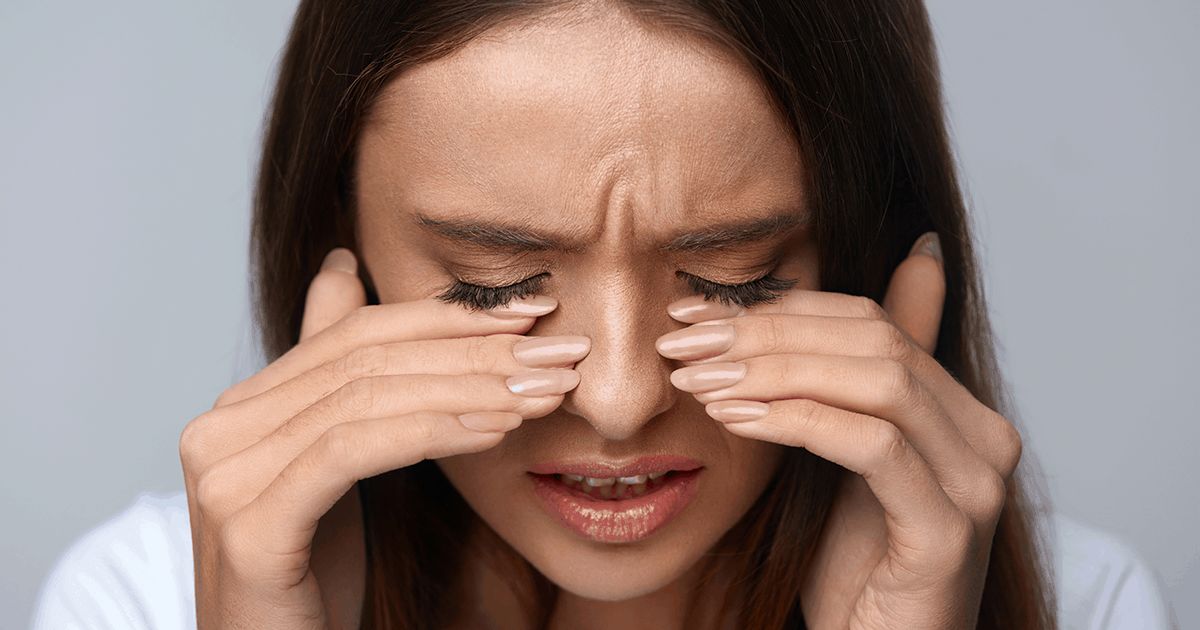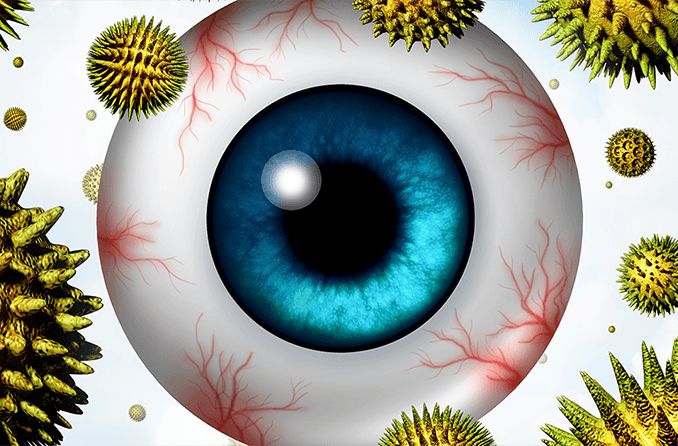Understanding eye pain
Eye pain can feel different for each person and vary, depending on the condition. It may feel like pressure, pounding, stabbing or even sand in the eye. Identifying the type of pain, its location and any accompanying symptoms can help you know when it’s time to see a doctor.
Sudden, severe eye pain, headaches, nausea or vision changes may indicate a medical emergency. If you experience any of these symptoms, contact your eye doctor immediately.
What does eye pain feel like?
Mild eye discomfort and irritation usually get better with cooling compresses or artificial tears. Eye strain from looking at digital devices often feels better after taking a break. Eye pain, however, is long-lasting and often does not get better without treatment.
The pain can affect only one eye or start in one eye and then spread to both. It may be felt as a wide range of sensations, including:
- Dull ache
- Pounding
- Stabbing
- Burning
- Piercing
- Pressure
- Sand-like feeling in the eye
- Tenderness
- Soreness
- A hot sensation
In addition, eye pain may have accompanying symptoms, such as:
- Sensitivity to light
- Redness
- Blurry vision
- Tearing or discharge
Where you feel pain provides important clues about what may be causing it. Eye pain can occur throughout the eye, including:
- On the surface of the eye
- Inside the eye
- Behind the eye
- With eye movement
How can you tell if eye pain is serious?
Occasional eye irritation or tiredness, like eye strain, is common and usually minor. It often goes away after resting your eyes. However, if the pain has a sudden onset, is severe or long-lasting or occurs with other symptoms, it may be due to a serious underlying condition.
Severe pain that does not improve or is accompanied by blurry vision requires immediate medical attention. This is especially important if the pain is worsening, even if the symptoms were mild at first.
Seek immediate medical attention if you experience pain along with any of the following symptoms:
- Sudden or severe loss of vision
- Trouble moving your eye fully
- Noticeable swelling in one or both eyes
- Seeing halos around lights
- Nausea or vomiting
- Fever, chills or extreme fatigue
- A strong feeling of pressure in the eyes
- Persistent pain
- Recent eye injury or a foreign object in the eye
Common causes of eye pain
All sensations from the face and head, such as temperature, touch and pain, travel to the brain via the trigeminal nerve, also known as the fifth cranial nerve. When this nerve is activated — by injuries, pressure, damage, dryness or irritants — the brain interprets it as pain.
Inflammation is an immune response that can irritate the inner tissues of the eye, making them highly sensitive to light and causing discomfort. Eye pain can also result from infections caused by viruses, bacteria or fungi. Additionally, changes in internal fluid pressure can contribute to pain and discomfort. Another factor is referred pain, where the brain misinterprets pain signals. Discomfort originating from the sinuses or teeth may be perceived as eye pain due to the convergence of nerve branches in the trigeminal nerve pathway.
Corneal abrasion
Pain type and symptoms: Intense pain at the front surface of the eyes with watering, light sensitivity and blurry vision.
A corneal abrasion is a scratch on the outer layer of the cornea. It is among the most common causes of eye pain. It causes intense pain because the cornea is highly sensitive. It is commonly caused by physical injury (such as a nail scratch), an object getting stuck in the eye or improper contact lens use.
Excessive watering, blurred vision and painful sensitivity to bright light often accompany the pain.
Keratitis
Keratitis is inflammation of the cornea that can be caused by dry eyes, scratches or injuries or infections.
Bacterial keratitis
Pain type and symptoms: Severe pain with blurred vision, redness, light sensitivity and discharge; more common among contact lens wearers.
Bacterial keratitis is an eye infection that can cause serious corneal damage if left untreated. Contact lens wearers are at higher risk, especially when lenses aren’t properly cleaned or are worn too long. In addition to severe pain, it can also cause blurry vision, redness, light sensitivity and discharge.
Viral keratitis
Pain type and symptoms: Pain, redness, rash and general discomfort; often associated with herpes simplex virus or herpes zoster (chickenpox/shingles).
Herpes virus infection of the cornea can cause pain, redness, rash and general discomfort. Herpes simplex virus type 1 (HSV-1) is the same virus that causes cold sores. It is the most common cause of viral keratitis. Herpes zoster, which causes chickenpox and shingles, is another virus that can infect the cornea. These viruses cause discomfort and pain, as well as chronic inflammation. They can also lead to painful corneal ulcers.
Fungal and Acanthamoeba keratitis
Pain type and symptoms: Significant, unbearable pain; often associated with plant eye trauma or swimming in contaminated water.
Fungal and parasitic infections, though less common, can cause severe and significant pain. Eye injuries, particularly those caused by vegetation, are the most common cause of fungal infections in the eye. Parasitic infections, such as Acanthamoeba (which live in fresh water and soil), can occur from contaminated contact lenses or from swimming in contaminated water.
Corneal ulcer
Pain type and symptoms: Severe pain, light sensitivity and discomfort; associated with corneal issues.
A corneal ulcer is keratitis that has developed into an open sore. This highly painful condition can appear as a white spot and symptoms of light sensitivity and irritation. It requires immediate treatment.
Dry eye
Pain type and symptoms: Chronic, burning, gritty eye sensation.
Dry eye syndrome is a very common, long-term problem that frequently involves both eyes. It occurs when the outer surface of the eye lacks sufficient moisture. When the front layer of the eye (the cornea) becomes overly dry, it can lead to damage to the cornea’s surface (epithelial defects). The resulting dryness and irritation can stimulate nerves, leading to pain and discomfort.
It is often described as a prickly, burning, gritty feeling. Other typical signs of dry eye include watery or red eyes. Common initial methods for managing dry eye involve frequent use of lubricating products, such as artificial tears.
Conjunctivitis (pink eye)
The conjunctiva is the clear membrane covering the white part of the eye and lining the inner eyelids. Inflammation of the conjunctiva is known as conjunctivitis or pink eye. There are various types of conjunctivitis, and the pain and discomfort can vary significantly, depending on the type.
Allergic conjunctivitis
Pain type and symptoms: Severe itching, resulting in sore, irritated eyes.
Discomfort or pain from an allergic reaction is commonly experienced as intense itching, stinging and watery eyes, often leading to soreness from rubbing.
Viral conjunctivitis
Pain type and symptoms: Irritated eyes with discomfort, redness and watery discharge.
This highly contagious form of pink eye is caused by the virus. Symptoms may include painful, irritated eyes with watery discharge. It is usually caused by the virus that is associated with cold or flu-like symptoms (adenovirus). Other viruses, such as COVID-19 and herpes, can also cause the condition. It usually resolves on its own within one to two weeks.
Bacterial conjunctivitis
Pain type and symptoms: Discomfort, redness and yellow-green discharge.
Bacterial conjunctivitis is common in school settings and also spreads easily. Symptoms include pain and discomfort, as well as yellowish eye discharge. It usually resolves on its own, but antibiotics may be needed.
Blepharitis
Pain type and symptoms: Soreness, swelling, itching and crusting along the lashes.
Blepharitis is inflammation of the eyelid margins. It usually affects both eyes and can cause soreness, discomfort, itching, burning or crusting along the lashes. It is often caused by clogged oil glands, skin issues or an infection. Symptoms can often be managed with regular eyelid cleansing and warm compresses. Antibiotic ointments or anti-inflammatory drops may be prescribed if symptoms are severe.
Stye
Pain type and symptoms: Painful, pimple-like bump on the edge of the eyelid.
A stye, or hordeolum, is a painful bump on the edge of the eyelid. It is caused by a bacterial infection of an eyelash hair follicle or an oil gland on the eyelid. The bumps usually occur on one lid but can also develop on both. A stye usually resolves within one to two weeks. Warm compresses are usually recommended as a home treatment. If a stye causes persistent pain and swelling that does not decrease, antibiotics may be needed to treat the infection.
Chalazion
Pain type and symptoms: An area of swelling on the eyelid with initial pain that gets better after a few days, although the swelling stays.
A chalazion, or eyelid cyst, is a swelling on the eyelid. It occurs when a small oil-secreting gland (the meibomian gland) becomes blocked. When the bump first appears, it can be tender and uncomfortable. This tenderness typically resolves, but if the swelling becomes large, it can press on the cornea, potentially blurring your vision. It often clears up in about four weeks with the application of warm compresses.
Dacryocystitis
Pain type and symptoms: Swelling, tenderness and redness near the inner corner of the eye.
Dacryocystitis results from a blockage of the tear drainage system. It causes swelling, tenderness and redness near the inner corner of the eye. It is usually seen in newborns but can affect children and adults. Treatment usually includes antibiotics or a minor surgery to allow tears to drain properly.
Contact lens irritation
Pain type and symptoms: Dull ache with a feeling of “sand in the eye” associated with contact lens wear.
Wearing contact lenses for too long or not cleaning them can lead to damage to the cornea, a condition called superficial punctate keratitis (SPK). This often causes a dull ache, along with a gritty feeling or a sense of something in the eye. People with contact lens irritation often also notice redness, excessive tearing and pain in bright light. If these symptoms occur, stop wearing lenses immediately and use lubricating eye drops for relief. If the irritation is severe or doesn’t improve quickly, see an eye doctor.
Sinus pressure or sinusitis
Pain type and symptoms: Pain behind the eyes that worsens with certain head positions.
Sinus pressure or sinusitis can cause eye pain. This is called “referred pain.” The brain confuses the source of the pain because the nerves from the eye and sinuses converge. Sinus-related aches can feel like headaches or facial soreness that changes with head position. The eye area usually looks normal, but some people may have swelling around the eye in addition to the pain.
Migraine
Pain type and symptoms: Throbbing pain around the eyes and head with light sensitivity or nausea.
Migraine headaches can cause discomfort and pain around the eye area. Irritation of certain nerve pathways associated with the eye can trigger a migraine. People often describe migraine pain as pounding or throbbing. These headaches usually come with other symptoms, like sensitivity to bright light. They may also cause stomach issues, such as nausea and vomiting. Sometimes, migraines are preceded by visual symptoms, like flashing lights or changes in sensation and balance known as an aura.
Acute angle-closure glaucoma
Pain type and symptoms: Sudden onset of throbbing, blurry vision and pain (caused by high eye pressure); may also have nausea.
Acute angle-closure glaucoma is an eye emergency. It occurs when fluid pressure inside the eye rises quickly due to a blockage in the drainage system. This pressure activates specialized cells that detect it, which then send signals along the main nerve pathway, resulting in severe pain. People with this condition often feel deep, throbbing pain in their eyes. They may also have headaches, nausea, vomiting and stomach discomfort. Vision can become blurred or reduced, and they might see bright rings or halos around lights. The front layer of the eye may appear hazy. Since this condition can rapidly lead to permanent vision loss, it must be treated immediately.
Eye trauma
Pain type and symptoms: Intense pain that may worsen with blinking, followed by eye injury.
The most common eye injuries are surface scrapes, called abrasions, or foreign particles stuck in the eye. Any damage to the cornea can cause intense pain or a gritty feeling that often worsens with blinking. If you have a history of an eye injury and are experiencing persistent pain, it is important to see an eye doctor as soon as possible.
Optic neuritis
Pain type and symptoms: Pain with eye movement; often associated with multiple sclerosis.
Optic neuritis is when the optic nerve becomes inflamed. This nerve sends visual information from the eye to the brain. People with this condition often experience mild eye discomfort that worsens with eye movement. Other symptoms include decreased vision and reduced color perception. Optic neuritis is a serious issue that needs immediate specialized care. This condition is often linked to multiple sclerosis or other systemic diseases.
Scleritis
Pain type and symptoms: Severe stabbing pain with red eye; often associated with an underlying systemic disease.
Scleritis is a rare and severe inflammation of the sclera, the white layer of the eye. The main symptom is intense, deep pain. This pain may radiate or cause headaches and usually worsens with eye movement. Other signs include redness, excessive tearing and sensitivity to bright light. In about half of diagnosed cases, scleritis is associated with an underlying disease. It is important to see an eye doctor as soon as possible if you have symptoms of scleritis.
Uveitis
Pain type and symptoms: Aching pain, light sensitivity, red and watery eye, blurred vision.
Uveitis is a rare condition that causes inflammation inside the eye. This inflammation occurs in the uvea, which includes the iris (anterior uveitis) and the tissue beneath the retina. Since this area contains sensory fibers, inflammation can cause pain. People with uveitis often feel achy eye pain that worsens with activities, like reading. Other common symptoms include sensitivity to bright light (photophobia), redness or excessive tearing and blurry vision. You might also notice dark spots (floaters) or flashes of light. It is important to see an eye doctor as soon as possible if you have these symptoms.
Orbital cellulitis
Pain type and symptoms: Pain, swelling and redness from the eyebrow to the cheek; more often seen in young children; a medical emergency.
Orbital cellulitis is a medical emergency. It is rare and caused by a bacterial infection affecting the tissues surrounding the eye. If not treated promptly, orbital cellulitis can lead to vision loss or life-threatening complications. It is more common in young children. This condition can cause pain, swelling and redness from the eyebrow to the cheek. Intravenous antibiotics are typically required, followed by oral antibiotics. With prompt treatment, most children recover fully.
How eye doctors diagnose the cause of eye pain
During your appointment, your doctor will assess your vision to check for any changes. They will use a slit lamp, an instrument that provides high magnification to examine the structures of your eye. The doctor may apply a temporary dye called fluorescein stain to your cornea. When illuminated with a specific cobalt blue light, this dye helps to reveal any scratches or injuries on the surface of your eye. Other routine assessments may include measuring the intraocular pressure, especially if glaucoma is a concern.
It is very important to inform your eye doctor about any discomfort you’ve been experiencing, including when it started, as well as any symptoms, like blurred vision or sensitivity to light.
How eye pain is treated or managed
Treatment for eye pain widely varies, depending on the underlying cause. Treatments may include various medications. For surface infections, antibiotic, antifungal or antiviral drops may be prescribed. For inflammation, NSAIDs or steroids may be needed. Emergency treatment is necessary for acute angle-closure glaucoma to quickly lower the pressure.
At-home treatments can help you manage symptoms and decrease the risk of an infection worsening:
- Use compresses and artificial tears.
- Wear sunglasses if they provide comfort.
- Stop wearing contact lenses and eye makeup.
- Use only the eye drops or ointment prescribed by your doctor.
- Don’t touch or rub the infected eye.
Preventing eye pain
Preventing eye pain and discomfort means adopting good habits for eye and contact lens care. First, maintain good hygiene. Wash your hands thoroughly before touching your eyes. Clean your face daily. Follow the proper schedule for cleaning and replacing your contact lenses.
Also, to reduce visual fatigue, take short breaks from focused tasks. Use the “20-20-20” rule: every 20 minutes, look at something 20 feet away for 20 seconds. Additionally, use lubricating eye drops (artificial tears) often to keep your eyes moist.
Additional strategies include:
- Avoid touching and rubbing your eyes.
- Schedule routine eye checkups.
- Use proper eye protection.
- Pay attention to changes in your vision.
- Eat a healthy diet.
When to see an eye doctor
If you experience eye pain or discomfort, it’s important to consult an eye doctor if your symptoms do not improve within a few days. You should seek immediate medical attention if you also have symptoms, such as nausea or changes in your vision. Additionally, see an eye doctor if you have:
- Changes in vision
- Progressively worsening eye pain
- An increase in symptoms
- Significant discharge
- Increased sensitivity to light
- Swelling or redness around the eyes or eyelids
- Headaches with eye symptoms
- Signs of corneal damage











